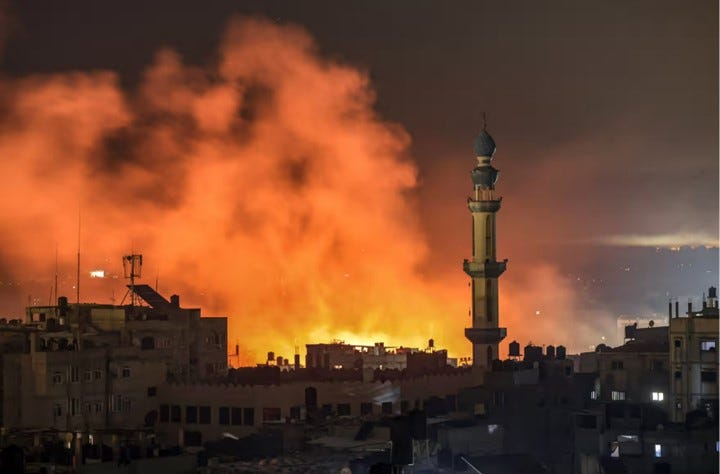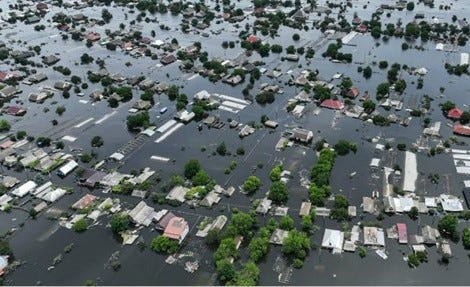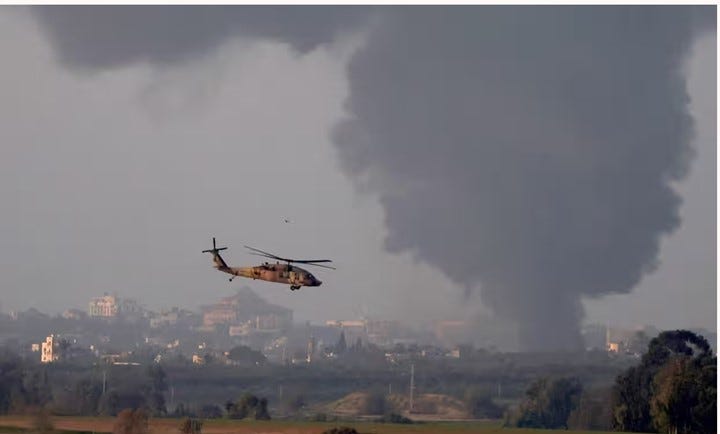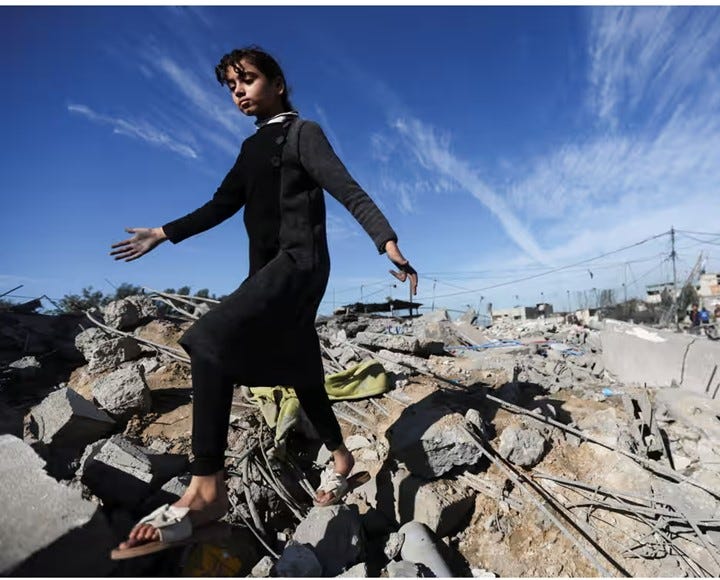The yoga, mindfulness, somatics, and psychology worlds feature more advocates for climate justice than the general population. Many of my colleagues ardently support efforts to save the whales, the elephants, the Hawksbill turtle, and to conserve water and other precious resources.
This is a good thing. It’s prosocial activism, the kind that benefits humanity.
Yet this brand of climate activism often supports the more “obvious” aspects of climate justice like endangered animals and resources, while overlooking others like environmental racism.
Thanks to intersectionality, however, all aspects of climate justice are embedded in one another. Environmental justice has always been connected with racial justice and equity.
If you fully support climate justice, that includes supporting the otheforms of justice it connects with.
And a key intersectional climate justice issue critical to our survival yet rarely discussed isthe fight for peace—that is to say, the fight against military imperialism.
In recent years, a growing chorus of voices have actually argued that climate crisis itself is a national security threat that demands investment in the military. (This smacks of racism; it hints at the “danger” of growing numbers of climate refugees “invading” Westen counties—refugees who pay the price for wealthy countries’ outsized predation of the world’s natural resources.)
To be sure, climate destruction threatens us all.
But one of the greatest threats to climate health—and therefore to our safety—is military conflict, no matter where in the world it occurs.
The Military Industrial Complex Pollutes Even in Peacetime
Even during times of peace, militaries consume vast amounts of dirty energy.
For example, the United States Department of Defense powers 566,000 buildings, which comprise a whopping 40% of its fossil fuel use. These include training facilities, dormitories, manufacturing plants, and other buildings on nearly 800 bases worldwide.
In countries such as Switzerland and the U.K., departments of defense similarly consume more fossil fuels than any other government agencies.
Militaries’ consumption of vast amounts of fossil fuels accelerates global warming. According to the Conflict and Environment Observatory (CEOBS), they uphold the global fossil fuel industry by ensuring demand for oil, gas, and coal.
Militaries account for 5.55 percent of global greenhouse gas emissions, say experts, making them among the world's highest polluters.
In fact, says CEOBS, if the world’s militaries were themselves a country, they would have the world’s fourth largest carbon footprint. (Russia is third, and India fifth.)
These figures could be even more extreme were it not for the fact that military emissions are hidden under a shroud of secrecy.
Countries with the world’s largest militaries—think the U.S., China, Russia, and Israel—do not even report their total emissions.
Warfare Under Cover
Strikingly, neither international law nor international climate agreements require militaries to report or to curb their carbon emissions.
The 1997 Kyoto Protocol on reducing greenhouse gases exempted military emissions abroad, from flying jets to sailing ships to training exercises. The 2015 Paris accords did the same. The grounds: that data on militart energy could undermine national security.
Some militaries maintain that making public the details of their emissions use would give rival nations a bird’s-eye view into their overseas operations.
As Markus Ruelke of the German Defense Ministry's environmental protection unit put it, "We would not want to let everybody know how much fuel we use in these missions – how far we fly, how far we drive, and what our exercise patterns are."
Doug Weir is the Director of the Conflict and Environment Observatory, a U.K.-based nonprofit that studies the environmental aspects of armed conflicts and military activities. Weir and others call this secrecy "military environmental exceptionalism.”
Today, environmental groups Tipping Point North South and The Conflict and Environment Observatory, along with academics from the British universities of Lancaster, Oxford and Queen Mary are among those pushing for more comprehensive and transparent military emissions reporting, using research papers, letter campaigns, and conferences in their lobbying drive.
When scientists began to collate and publish the emissions data that militaries report to the UNFCCC (United Nations Framework Convention on Climate Change), they learned that few countries publish even the bare minimum that UN reporting guidelines require. Many countries with large militaries publish no data at all.
“Those that do often report partial figures,” said Dr. Stuart Parkinson, executive director of the Scientists for Global Responsibility, in an interview with The Guardian. “So figures for military aircraft could be hidden under ‘aviation,’ military tech industry under ‘industry,’ military bases under ‘public buildings,’ etc. Indeed, it’s not just the public who are unaware, the policymakers are also unaware, and even the researchers.”
But this is starting to change.
In the first five months of 2023, more than 17 peer reviewed papers on military emissions were published. This numbered three times the number for all of 2022, and more than the previous nine years combined, according to one campaigner who tracks the research.
This secrecy begs the question: If emissions are this dangerous during times of peace, what happens to our climate during military conflict, both in the conflict area and around the world?

Ecocide: The Price of Imperialism
The word ecocide comes from the Greek oikos, meaning home or dwelling place and the Latin cadere, meaning to kill. The term refers to the large-scale destruction of the natural world.
The designation of ecocide was first used to describe the human and environmental devastation that the U.S. military caused by its use of Agent Orange in the Vietnam War. Agent Orange production ended in the 1970’s. But the damage was done: As many U.S. Vietnam veterans know, its key ingredient, dioxin, has been linked to numerous illnesses and disabilities, including cancer, diabetes, and birth defects.
According to the Red Cross, 3 million Vietnamese people have been affected by dioxin, including at least 150,000 children born with serious birth defects. Millions of Americans and Vietnamese are still affected, directly and indirectly, by the U.S. wartime spraying of Agent Orange and other herbicides over Vietnam.
Other examples of ecocide include:
the Chernobyl nuclear explosion of 1986
the deforestation of the Amazon (which saw the destruction of trees as vast as the entire country of France)
a series of oil spills that have contaminated the River Delta
the dumping of plastic in the Pacific ocean, creating the world’s worst landfill—three times the size of France.
One of the hallmarks of ecocide is the comet-tail of destruction it leaves on future generations. For this reason, NGO’s and other advocacy groups are lobbying for its official inclusion in the category of “crimes against humanity.”
Ecocide threatens all human populations who are dependent on natural resources for maintaining their ecosystems (and their lives), and for ensuring the survival of future generations.
And that makes it an ideal instrument to aid and abet genocide.
As of this writing, ecocide is still not included as part of the International Criminal Court’s (ICC) Rome Statute, which includes genocide, crimes against humanity, war crimes, and the crime of aggression. However, several nations have ruled ecocide to be a crime, including Kazakhstan, the Kyrgyz republic, Tajikistan, Georgia, Belarus, Ukraine, Moldova, Armenia, and—ironically—Russia.
Ecocide is a “byproduct” of military engagement for many reasons, including:
methods of modern warfare, such as bombing and attacks on critical infrastructure, don’t just emit fossil fuels; they reduce the biodiversity of ecosystems
the damages of conflict, including noise and air pollution, can kill up to 90% of large animals in an area of conflict
pollution caused by war also contaminates bodies of water, soil, and air, making areas unsafe for people to inhabit.
Russia’s War on Ukraine
In 2022 alone, military expenditure rose by 3.7 percent, reaching a record high of $2.24 trillion. This dramatic increase was due largely to Russia’s invasion of Ukraine.
Russia’s war in Ukraine launched the first attempt to document conflict-related emissions in detail. This has required researchers to develop novel methodologies to measure the damage to the ecosystem caused by war.
A report from Dutch carbon accounting expert Lennard de Klerk estimated the first 12 months of the war in Ukraine will trigger a net increase of 120 million tons of greenhouse gases, equivalent to the annual output of Singapore, Switzerland and Syria combined.
And in August of 2023, the Initiative on Greenhouse Gas Emissions (GHG) estimated that the total emissions of the war (at only 18 months) amounted to to the equivalent of the annual emissions of a country such as Belgium.
The report includes a legal analysis to help hold Russia accountable for the climate damages caused by the war, plus methods for rebuilding Ukraine in environmentally sustainable ways.
Over one-third of these emissions relates to the reconstruction of Ukraine.
One of the most devastating examples of ecocide in Russia’s War on Ukraine was the explosion of the Kakhovka Dam on June 6, 2023. (You can view a pictorial of the impact, and read why experts believe Russia is responsible, here.)

The Kakhovka Dam, located in the city of Nova Kakhovka in the Kherson region of Ukraine, manages the flow of the Dnipro River, which extends from northernmost Ukraine all the way south to the Black Sea. The Dam holds a large reservoir at bay, supplies water for countless communities, and serves as a cooling source for the Zaporizhzhia Nuclear Power Station.
The catastrophic breach of the dam triggered a domino effect of environmental hazards:
the flood drowned many people and displaced thousands
it submerged vast expanses of agricultural farmland, villages, and towns downstream of the breach—according to estimates as many as 10,000 hectares or 25,000 miles
it disrupted 31 irrigation systems supplying fields in surrounding oblasts which provide irrigation for half a million hectares and which further supports the production of 4 million tons of grain and oilseeds valued at $1.5 billion
it also dislodged countless landmines
farm animals’ corpses could pose an epidemic threat
the steppe areas where many rare Red Data Book animals live are flooded, leading to a loss of endangered animals
The Halo Trust, a landmine clearance organization, conducted surveys in the region; they found more than 5,000 anti-tank mines, many of which were submerged underwater. The scale of mine contamination, they say, surpasses any other conflict since World War II, particularly on the Russian-controlled side of the Dnipro River, where the Russian army had installed an extensive network of land mines.
The Kakhovka dam collapse is being called a “new Chernobyl.”
But the consequences don’t affect Ukraine alone.
The issue of drought in southern Ukraine threatens the food security of African and Asian countries who rely on Ukrainian grain. This will likely increase the price of grain, intensify food shortages in world markets, and exacerbate famine in less-resourced countries. These effects compound the existing grain crisis that Russia has caused by its blockade of the Black Sea trade routes and stealing grain from Ukrainian territories.
Ukraine is not the only site of ecocide; there is a rising demand for emissions data concerning Israel’s War against Gaza.
The preliminary indications should alarm even the most climate-agnostic among us.
The Climate Costs of Israel’s War on Gaza
Strikingly, the planet-warming emissions generated during the first two months of the war on Gaza has now outpaced the annual carbon footprint of more than 20 of the world’s most climate-vulnerable nations.
A groundbreaking new study by researchers in the U.K. and U.S. found that Israel’s bombardment and ground invasion of Gaza has generated more than 99 percent of the whopping 300,000 metric tons of carbon emissions in only the first two months of the war.
Conservative estimates say that the climate cost in the first two months equates to the burning of over 150,000 tons of coal. This includes CO2 from aircraft missions, tanks, and fuel artillery, and rockets.
And almost half these emissions come from U.S. cargo planes flying military supplies to Israel.

During the same period, rockets fired by Hamas generated approximately 300 tons of coal (compared to Israel’s 150,000), a contrast which emphasizes the glaring asymmetry of the conflict.
Corey Scher of the CUNY Graduate Center and Jamon Van Den Hoek of Oregon State University are experts in mapping damage during wartime. They have worked together to map the destruction caused across several war zones.
Their analysis of Copernicus Sentinel-1 satellite data yielded shocking comparisons.
The data indicates that in just the first two months of the war, Israel’s offensive has caused greater destruction than the razing of Syria’s Aleppo in the four-year period from 2012 to 2016, Ukraine’s Mariupol, or the Allied bombing of Germany in World War II.
Israel’s military campaign, experts say, is the most destructive in recent history.
And it has killed more civilians than the U.S.-led coalition in its three-year campaign against the Islamic State.
“Gaza is now a different color from space—it’s a different texture,” Scher observed.
Even prior to the current war, Gaza’s climate crisis was already acute, including a rise in sea levels, drought, and extreme heat, all of which threatened water supplies and food security independent of Israel’s restrictions on food and water in Gaza.
Much of Gaza’s farmland, energy and water infrastructure has been destroyed or polluted, with devastating health implications for decades to come, say experts.
The destruction of buildings in Gaza poses additional problems for the global climate crisis. More than half of Gaza’s buildings—over 100,000—have been damaged or destroyed by Israeli bombardment in the 100 days since the war began.
And rebuilding is a major source of global warming. New research calculates that the carbon cost of rebuilding Gaza’s damaged structures using contemporary techniques will generate at least 30 million metric tons of warming gases.
This is on a par with New Zealand’s annual CO2 emissions and higher than 135 other countries and territories including Sri Lanka, Lebanon, and Uruguay.
David Boyd, the UN special rapporteur for human rights and the environment, said in an interview with The Guardian:
“This research helps us understand the immense magnitude of military emissions—from preparing for war, carrying out war and rebuilding after war. Armed conflict pushes humanity even closer to the precipice of climate catastrophe, and is an idiotic way to spend our shrinking carbon budget.”
Benjamin Neimark, a senior lecturer at Queen Mary University of London (QMUL) and co-author of the research published this month on Social Science Research Network, spoke to The Guardian about the bigger picture of the conflict. “This study is only a snapshot of the larger military boot print of war… a partial picture of the massive carbon emissions and wider toxic pollutants that will remain long after the fighting is over,” he said.

“The military’s environmental exceptionalism allows them to pollute with impunity, as if the carbon emissions spitting from their tanks and fighter jets don’t count,” he added. “This has to stop, to tackle the climate crisis we need accountability.”
Hadeel Ikhmais, head of the climate change office at the Palestinian Environmental Quality Authority, said: “We are trying to do our part on the climate crisis but even before the war in Gaza, it is hard to adapt and mitigate when we cannot access water or land or any technologies without Israel’s permission.”
“The role of the U.S. in the human and environmental destruction of Gaza cannot be overstated,” said co-author Patrick Bigger, research director at the thinktank CCP.
Zena Agha, policy analyst at the Palestinian Policy Network Al-Shabaka, writes about the climate crisis and the Israeli occupation. “The military detritus will continue to live in the soil, the earth, the sea and the bodies of the Palestinians living in Gaza—just as it does in other postwar contexts such as Iraq,” Agha said.
How Does This End?
We know already that indigenous people pay an outsized price for the emissions of the world’s wealthiest countries—and militaries like the U.S., Israel, China, and Russia.
This ends when we make the connections between the current climate crisis imperialism, and racial inequity—and when we commit to ending them.
Not only yogis, but many elected leaders support climate action but don’t support a ceasefire.
In my home state of Massachusetts, for example, Senator Edward Markey has a long history of supporting climate activism. His website states,
“Markey also served as the Chairman of the Select Committee on Global Warming & Energy Independence. He was the House co-author of the only comprehensive climate change bill to ever pass a chamber of Congress, and was the principal House author of the 2007 fuel economy law, the Appliance Efficiency Act of 1987, and the law that established the Northeast Home Heating Oil Reserve.”
Yet Markey also supports Israel, and with it, the very military causing genocide and ecocide in Gaza.
These positions inherently conflict.
Love environmental activism but still on the fence about supporting a ceasefire?
If this doesn’t convince us all that ceasing military hostilities and actively promoting peace is one of the most effective ways to save this Planet, I’m not sure what will.
Sources:
For example, the United States Department of Defense powers 566,000 buildings: Crawford, N. C. (2019, June 12). The Defense Department is worried about climate change – and also a huge carbon emitter. The Conversation. http://theconversation.com/the-defense-department-is-worried-about-climate-change-and-also-a-huge-carbon-emitter-118017
And countries with some of the world’s largest militaries: Neimark, B., Weir, D., & Belcher, O. (2021, November 9). How the world’s militaries hide their huge carbon emissions. The Conversation. http://theconversation.com/how-the-worlds-militaries-hide-their-huge-carbon-emissions-171466
Furthermore, according to the Conflict and Environment Observatory: How does war damage the environment? (2020, June 4). CEOBS. https://ceobs.org/how-does-war-damage-the-environment/
The damages of conflict, including noise and air pollution, can kill up to 90%: How War Impacts Climate Change and the Environment. (2022, April 6). Global Citizen. https://www.globalcitizen.org/en/content/how-war-impacts-the-environment-and-climate-change/
In fact, says CEOBS, if the world’s militaries were a country: Report: Estimating the military’s global greenhouse gas emissions. (2022, November 10). CEOBS. https://ceobs.org/estimating-the-militarys-global-greenhouse-gas-emissions/
As Markus Ruelke of the German Defence Ministry's environmental protection unit put it: Mcfarlane, S., Volcovici, V., & Volcovici, V. (2023, July 10). Insight: World’s war on greenhouse gas emissions has a military blind spot. Reuters. https://www.reuters.com/business/environment/worlds-war-greenhouse-gas-emissions-has-military-blind-spot-2023-07-10/
When scientists began to collate and publish the emissions data: The climate costs of war and militaries can no longer be ignored. (2024, January 9). The Guardian. https://www.theguardian.com/commentisfree/2024/jan/09/emission-from-war-military-gaza-ukraine-climate-change
“Those that do often report partial figures,” Dr. Stuart Parkinson: Ambrose, T. (2021, November 11). World’s militaries avoiding scrutiny over emissions, scientists say. The Guardian. https://www.theguardian.com/environment/2021/nov/11/worlds-militaries-avoiding-scrutiny-over-emissions
In 2022 alone, due largely to Russia’s invasion of Ukraine: Trends in World Military Expenditure, 2022. (2023). SIPRI. https://www.sipri.org/publications/2023/sipri-fact-sheets/trends-world-military-expenditure-2022
But as many U.S. Vietnam veterans know, dioxin has been linked to: What is Agent Orange? (n.d.). The Aspen Institute. Retrieved January 24, 2024, from https://www.aspeninstitute.org/programs/agent-orange-in-vietnam-program/what-is-agent-orange/
As of this writing, however, ecocide is still not included as part of the: Hillsdon, M., & Hillsdon, M. (2023, February 20). Society Watch: Drive to make ecocide an international crime gains momentum. Reuters. https://www.reuters.com/business/sustainable-business/society-watch-drive-make-ecocide-an-international-crime-gains-momentum-2023-02-20/
Several nations have ruled ecocide to be a crime, including: Ecocide: Definition and Examples. (n.d.). Retrieved January 24, 2024, from https://greenly.earth/en-us/blog/ecology-news/ecocide-definition-and-examples
A report from Dutch carbon accounting expert Lennard de Klerk: Mcfarlane, S., Volcovici, V., & Volcovici, V. (2023, July 10). Insight: World’s war on greenhouse gas emissions has a military blind spot. Reuters. https://www.reuters.com/business/environment/worlds-war-greenhouse-gas-emissions-has-military-blind-spot-2023-07-10/
In August of 2023, the Initiative on Greenhouse Gas Emissions (GHG) updated their estimate: Climate Damage caused by Russia’s war in Ukraine. (n.d.). Climate Focus. Retrieved January 24, 2024, from https://climatefocus.com/publications/ukraine-war-climate-damage-updated/
You can view a pictorial of the impact, and read why experts believe Russia is responsible: Glanz, J., Santora, M., Robles, P., Willis, H., Leatherby, L., Koettl, C., & Khavin, D. (2023, June 16). Why the Evidence Suggests Russia Blew Up the Kakhovka Dam. The New York Times. https://www.nytimes.com/interactive/2023/06/16/world/europe/ukraine-kakhovka-dam-collapse.html
It submerged vast expanses of agricultural farmland: Ministry: 10,000 hectares of arable land expected to be flooded in Kherson Oblast. (2023, June 7). The Kyiv Independent. https://kyivindependent.com/agriculture-ministry-10-000-hectares-of-land-in/
It disrupted 31 irrigation systems supplying fields in surrounding oblasts: Nguyen, L. (2023, June 28). The Environmental Impact of the Kakhovka Dam Explosion in Ukraine. Earth.Org. https://earth.org/the-environmental-impact-of-the-kakhovka-dam-explosion-in-ukraine/
The Halo Trust, a landmine clearance organization, conducted surveys: Kosstutschenko, A. (Director). (2023, June 16). US Halo Trust Helps Demine Ukraine’s Mykolaiv Region. https://www.voanews.com/a/us-halo-trust-helps-demine-ukraine-s-mykolaiv-region-/7140323.html
The issue of drought in southern Ukraine threatens the food security of African: Aftermath of the Kakhovka Dam Collapse | Wilson Center. (n.d.). Retrieved January 24, 2024, from https://www.wilsoncenter.org/blog-post/aftermath-kakhovka-dam-collapse
Strikingly, the planet-warming emissions generated during the first two months of the war: Lakhani, N., & reporter, N. L. C. justice. (2024, January 9). Emissions from Israel’s war in Gaza have ‘immense’ effect on climate catastrophe. The Guardian. https://www.theguardian.com/world/2024/jan/09/emissions-gaza-israel-hamas-war-climate-change
In a groundbreaking new study by researchers in the U.K. and U.S., Israel’s: Lakhani, N., & reporter, N. L. C. justice. (2024, January 9). Emissions from Israel’s war in Gaza have ‘immense’ effect on climate catastrophe. The Guardian. https://www.theguardian.com/world/2024/jan/09/emissions-gaza-israel-hamas-war-climate-change
During the same period, rockets fired by Hamas generated approximately 300 tons: Lakhani, N., & reporter, N. L. C. justice. (2024, January 9). Emissions from Israel’s war in Gaza have ‘immense’ effect on climate catastrophe. The Guardian. https://www.theguardian.com/world/2024/jan/09/emissions-gaza-israel-hamas-war-climate-change
The data indicates that in just the first two months of the war, Israel’s offensive: Israel’s military campaign in Gaza seen as among the most destructive in recent history, experts say. (2023, December 21). AP News. https://apnews.com/article/israel-gaza-bombs-destruction-death-toll-scope-419488c511f83c85baea22458472a796
The destruction of buildings in Gaza poses additional problems: Chase, W. (2024, January 14). 100 days of war: Over 50% of Gaza buildings damaged or destroyed in Israel’s bombardment. Axios. https://www.axios.com/2024/01/14/gaza-building-damage-israel-war
New research calculates that the carbon cost of rebuilding Gaza’s damaged structures: Lakhani, N. (n.d.). The staggering carbon footprint of Israel’s war in Gaza. Mother Jones. Retrieved January 21, 2024, from https://www.motherjones.com/politics/2024/01/gaza-israel-war-hamas-carbon-emissions-climate-damage/
In an interview with The Guardian, David Boyd, the UN special rapporteur: Lakhani, N., & reporter, N. L. C. justice. (2024, January 9). Emissions from Israel’s war in Gaza have ‘immense’ effect on climate catastrophe. The Guardian. https://www.theguardian.com/world/2024/jan/09/emissions-gaza-israel-hamas-war-climate-change
Benjamin Neimark, a senior lecturer at Queen Mary University of London (QMUL) and: Lakhani, N., & reporter, N. L. C. justice. (2024, January 9). Emissions from Israel’s war in Gaza have ‘immense’ effect on climate catastrophe. The Guardian. https://www.theguardian.com/world/2024/jan/09/emissions-gaza-israel-hamas-war-climate-change
Even prior to the current war, Gaza’s climate crisis was already acute: Lakhani, N., & reporter, N. L. C. justice. (2024, January 9). Emissions from Israel’s war in Gaza have ‘immense’ effect on climate catastrophe. The Guardian. https://www.theguardian.com/world/2024/jan/09/emissions-gaza-israel-hamas-war-climate-change
Hadeel Ikhmais, head of the climate change office at the Palestinian Environmental Quality Authority, said: Lakhani, N., & reporter, N. L. C. justice. (2024, January 9). Emissions from Israel’s war in Gaza have ‘immense’ effect on climate catastrophe. The Guardian. https://www.theguardian.com/world/2024/jan/09/emissions-gaza-israel-hamas-war-climate-change




This newsletter long gaan 🥲🤲